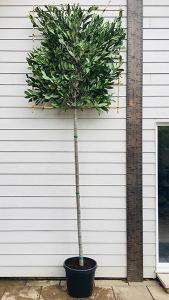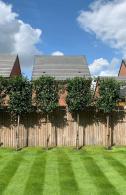Laurus Nobilis Pleached Bay Tree
Bay Tree Pleached
1. Add items to basket
2. Go to the basket
3. Enter your postcode in Delivery Price Check
Plant shape: Multi-stemmed
Plant variety: Frame 1.2 m High x 1.2 m Wide
Trunk height: 1.2 m
Pot size: 35-50 Litres
Plant ID: 15381 C 42
View plant size:LIMITED STOCK only 1 available
- then no more stock of this size
To check delivery cost add your plants to basket, then you can type your postcode in our Quick Delivery Price Check.


Laurus Nobilis is the popular bay leaf tree that holds the RHS Award of Garden Merit. This pleached tree version creates an ideal evergreen screen above the fence level. Bay trees are native to southern Europe and thrive here in many forms including the pleached, full standard and shrub form for hedging. Our pleached trees have long clear stems with the crowns trained flat (laterall) on square bamboo support frames. As the tree matures the crown will fill out into a cube. Pleached bay trees are excellent screens as they block the view from a neighbour’s upstairs window, but the bare trunk keeps your garden uncluttered. If you’d preferred a leafed stem, try our pleached bay screens.
Read our blog on Pleached Tree Care & How To Plant Pleached Trees
The leaves of our pleached bay tree are narrowly ovate, leathery and especially tactical. When rubbed they have a distinctive warm and delicious fragrance. Bay is a staple herb typically added to Mediterranean dishes to add a rich, deep flavour. Bay trees hold onto their leaves all year-round, and in spring small greenish-yellow flowers appear in dense clusters which are not particularly noticeable to us but are loved by pollinators. The RHS have also given Laurus Nobilis the Plant for Pollinators tag because it’s so attractive to bees and butterflies. Following the flowers, Lauris Nobilis produce small black glossy berries that attract birds.
How Hardy Are Laurus Nobilis Pleached Trees
Pleached bay trees are hardy throughout most of the UK down to temperatures of minus 10 if the roots are well-drained. They enjoy hot weather and have strong pest resistance.
How To Use Laurus Nobilis Pleached Trees
Pleached trees are often used as above fence line screening to get the ‘hedge on stilts’ effect. They’ve been used for hundreds of years in formal gardens but have become popular in small modern gardens as their clear stem leaves room in compact spaces and their cubed crown forms a contemporary shape.
Plant pleached bay trees to block out the neighbours and create shady spaces. For a hedge-line without gaps plant so the frames are just touching. You can also use pleached bay trees to create tunnels in larger spaces and as an unusual cubed specimen tree. Don’t forget to add a leaf or two to your pasta dishes and stews.
How To Care For Laurus Nobilis Pleached Trees
Pleached bay trees will grow in most soils of any pH, including chalk. The soil should be moist but well-drained and preferably sited in a sunny spot as these are sun-loving trees.
Dig out a hole one third wider than the root ball and as deep as the soil mark on the tree’s stem. Plant it up with plenty of good quality compost and water regularly until they are established. Once planted, all you will need to do is trim them once or twice a year to maintain the form and tie in any new shoots. Any shoots overgrowing the framework should be clipped off.
There is no need to remove the bamboo framework unless you want to. It’s best to wait until the branches are sufficiently mature to maintain the shape.
Other forms of Lauris Nobilis include Full Standard Bays, Bay Topiary Lollipop, Twisted Stem Bay Trees and Topiary Bay Cones.












